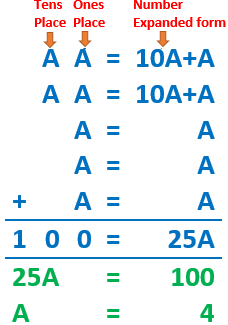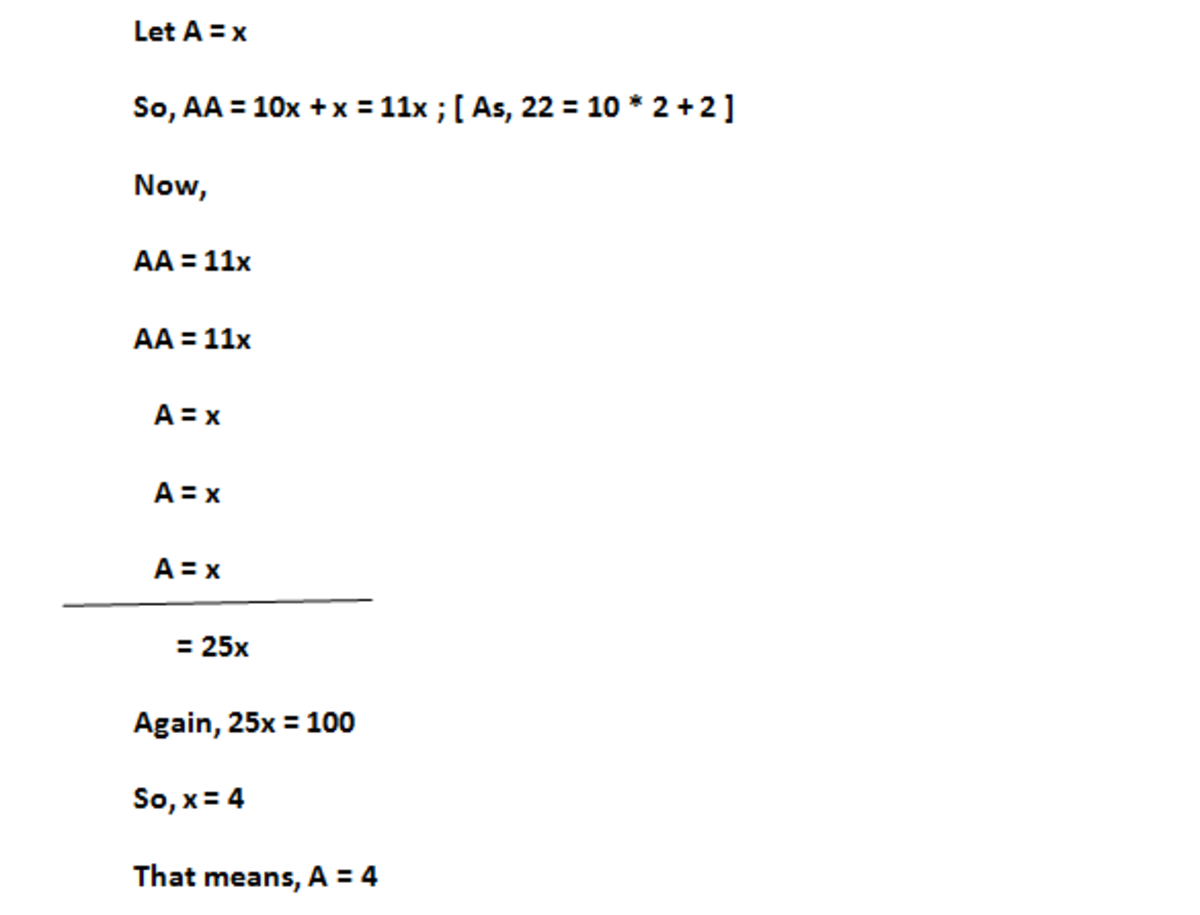This section requires Javascript.
You are seeing this because something didn't load right. We suggest you, (a) try
refreshing the page, (b) enabling javascript if it is disabled on your browser and,
finally, (c)
loading the
non-javascript version of this page
. We're sorry about the hassle.
15 solutions

why 10? in the beginning the only thing in my mind was A times A = A square so 2(a)^2 + 3 a = 100 but got confused a is 10 a how did you find that
Log in to reply
Why 10 in the beginning?
Log in to reply
Because it is in the tens place. AA can be written as = (A x10) +A =10A + A in the expanded number form using base 10. – Venkatachalam J
It is in the number expanded form. "A" is a single digit. In "AA" the left most "A" is in tens place and right most is in the once place. Therefore it is written as "10A+A". If you check with any two digit number you will get it quickly. For example the number "27" can be written in the expanded form (2x10)+7=20+7.
Nice. I had once seen a similar cryptogram where there were 8 8's that made a 1000.
Based on the comments I updated the required modification. I hope, it will clear and understandable.
( 1 0 A + A ) + ( 1 0 A + A ) + A + A + A = 2 5 A
2 5 A = 1 0 0
A = 4
25 plus 4 equals 100
@Agnishom Chattopadhyay You can represent numbers like 55, 31, 72, etc... as 5 * 10+5, 3 * 10+1 and 7 * 10+2 respectively. Try and think how that fact applies to this problem.
Could you explain how you got the 5 and 20 in 5A + 20A?
To a novice, there is nothing obvious about this solution. No idea what the different columns represent, how to interpret them, or how they interact. Back to 2+2=4, my favorite.
Yes you have shown that A=4 is a solution, but is it possible that there are other possible solutions as well? Why or why not?
3A + 11A +11A =100 A (3+11+11) =100 A = 100/25 = 4
11xA+11xA+3xA=100
25A=100
A=4
This is assuming that you have a base 10 system. if the base was0, the A could also be zero. which is a silly problem ut points out that a second solution is real, depending on the base used. A=b *2/(2 b+5) b being your base.
I like your thinking :)
If the base is a positive integer, what other solutions can we have (where A is also an integer)?
Just by glancing at it, we know that 0 and 2 are automatically out , because the numbers they yield are TOO SMALL:
0 ----> (00+00=0)
2----> (22+22+2+2+2=44+6<100)
In the same instance, we also know that that 6 and 8 are automatically out due to the fact that the numbers that they yield, are too LARGE to begin with. Doubling the double digit numbers, alone, would yield a number GREATER than 100:
6 ---> (66+66>100)
8 ---> (88+88>100).
Therefore, the only logical answer must be 4:
4 ---> 44+44+4+4+4=88+12= 100
i got the right answer but i did it a completely different way i took it as an a and another a and since they were right next to each other i took the 2 a's and put it as 44 and 44 times 2 is 88 and 88 + 12 = 100
Sorry, I did not understand what you meant.
A=4 . 6 and 8 are too high a value/s, and 0 just equals 0. This leaves 2 and 4. However, A cannot be 2 because 22+22+2+2+2 will only equal 50. So it makes sense that when you double the value 2 to make 4, you double the result of the AA + AA + A + A + A, and so 50 becomes 100. Also. 2 lots of 44 (= to AA) equal 88, and 3 lots of 4 (= to A) equal 12. 88 + 12 = 100
Yeah, so out of all the options, A = 2 works, but can A be equal to 1,3,5,7, or 9 as well?
I just went through each number. A = 2 isn't it as it would equal fifty A = 6 or 8 aren't it, as they would equal numbers over 100. A = 0 would just be 0 So A = 4
Yup, A=4 is correct. But is there a more systematic way to solve this without resorting to trial and error?
just find the larger two and the last ones become easier. try all the numbers displayed to help. if AA=2, then it would total to 50, not 100. if you took 6, then you would find that wouldnt work, right away. 66+66=132, and thats over 100 already. plus, 0 added to itself makes 0, so thats not the answer. the answer is, AA=44, so 44+44= 88, and A+A+A= 12, (4+4+4=12) and 88+12=100. Its not that complicated. Isnt this supposed to be hard? I could have solved this in sixth grade, and right now I'm in eighth. Take that for a smart kid.
Yup, you have experimented for all the possible values of A, but is it possible to get the answer without experimenting with all these options?
